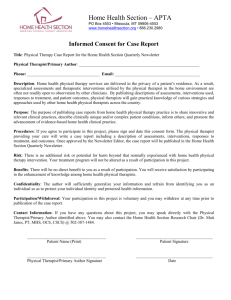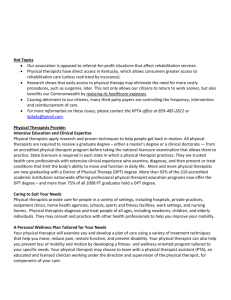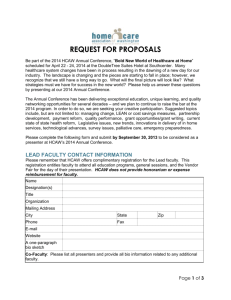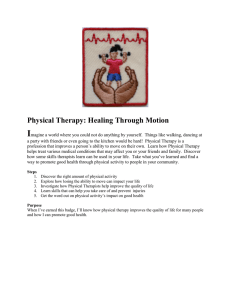Physical Therapy Annotated Bibliography
advertisement
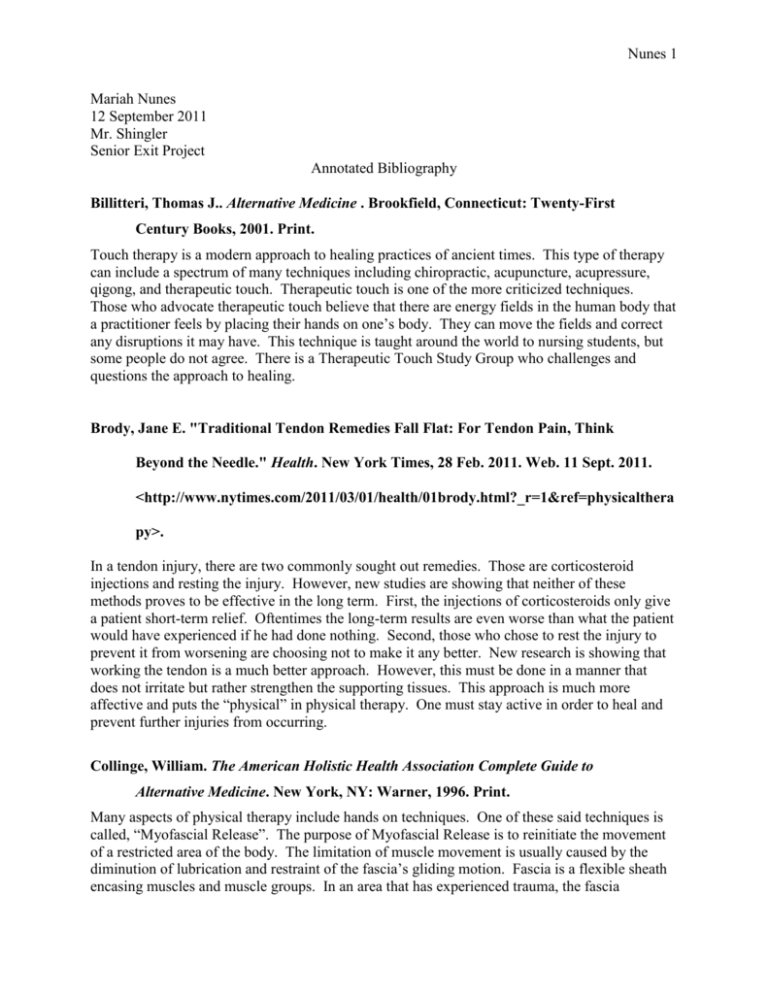
Nunes 1 Mariah Nunes 12 September 2011 Mr. Shingler Senior Exit Project Annotated Bibliography Billitteri, Thomas J.. Alternative Medicine . Brookfield, Connecticut: Twenty-First Century Books, 2001. Print. Touch therapy is a modern approach to healing practices of ancient times. This type of therapy can include a spectrum of many techniques including chiropractic, acupuncture, acupressure, qigong, and therapeutic touch. Therapeutic touch is one of the more criticized techniques. Those who advocate therapeutic touch believe that there are energy fields in the human body that a practitioner feels by placing their hands on one’s body. They can move the fields and correct any disruptions it may have. This technique is taught around the world to nursing students, but some people do not agree. There is a Therapeutic Touch Study Group who challenges and questions the approach to healing. Brody, Jane E. "Traditional Tendon Remedies Fall Flat: For Tendon Pain, Think Beyond the Needle." Health. New York Times, 28 Feb. 2011. Web. 11 Sept. 2011. <http://www.nytimes.com/2011/03/01/health/01brody.html?_r=1&ref=physicalthera py>. In a tendon injury, there are two commonly sought out remedies. Those are corticosteroid injections and resting the injury. However, new studies are showing that neither of these methods proves to be effective in the long term. First, the injections of corticosteroids only give a patient short-term relief. Oftentimes the long-term results are even worse than what the patient would have experienced if he had done nothing. Second, those who chose to rest the injury to prevent it from worsening are choosing not to make it any better. New research is showing that working the tendon is a much better approach. However, this must be done in a manner that does not irritate but rather strengthen the supporting tissues. This approach is much more affective and puts the “physical” in physical therapy. One must stay active in order to heal and prevent further injuries from occurring. Collinge, William. The American Holistic Health Association Complete Guide to Alternative Medicine. New York, NY: Warner, 1996. Print. Many aspects of physical therapy include hands on techniques. One of these said techniques is called, “Myofascial Release”. The purpose of Myofascial Release is to reinitiate the movement of a restricted area of the body. The limitation of muscle movement is usually caused by the diminution of lubrication and restraint of the fascia’s gliding motion. Fascia is a flexible sheath encasing muscles and muscle groups. In an area that has experienced trauma, the fascia Nunes 2 oftentimes gets “stuck” and restricts the usual gliding motion of the muscles. Myofascial Release manipulates the muscles and provides the release of the fascia easing pain and healing patients. This technique mends the source of pain rather than masks it. Garrick, James G., and Peter Radetsky. Anybody's Sports Medicine Book: The Complete Guide to Quick Recovery From Injuries. Berkeley: Ten Speed, 2000. Print. Those who need assistance strengthening and regaining range-of-motion often seek a physical therapist. Physical therapists are professionally trained to combat a patient’s specific weaknesses and get them in condition to live their life normally again. However, the job of a physical therapist is not to passively make a patient well again. It is to actively do so. However, some therapists are reluctant to provide patients with the ability to do their own exercises and therapy at home. Therein lies a controversy. Therapists may be unwilling because they do not have the time to instruct their patients, make handouts, or written instructions. In a busy therapy center, time is everything. However, after a few visits, a patient needs to be able to treat his or herself. Therapy should be focused on in the home, and supplemented in an actual center. Helfand, Duke. "More Hospitals Offering Alternative Therapy Services." Los Angeles Times. 8 Sept. 2011. Web. 09 Sept. 2011. <http://www.latimes.com/business/la-fi-alternative-medicine20110908,0,5074014.story?track=icymi>. Responses to patient demand means integrating massage therapy, acupuncture, and many other alternatives means of rehabilitation into hospitals. A recent national survey is showing that more and more medical care facilities are adding such techniques including meditation, homeopathy, relaxation training and chiropractics. The study shows forty-two percent of hospitals in the United States offer theses services. That is significantly higher than the thirty-seven percent that had them in 2007. However, forty-two percent is still less than half, meaning that more than half of the United States’ hospitals do not offer therapy services. Although, sixty-five percent do have services to treat pain, yet they do not heal the cause. Jette, Alan M. "Physical Disablement Concepts for Physical Therapy Research and Practice." Journal of the American Physical Therapy Association (1994): 1072-073. Society, families, and individuals are all affected by disability, which is considered “one of modern society’s greatest public health problems” (Jette). It is critical that society understands all the processes and complexities of disability. For that reason, some major models are being developed to direct physical therapy clinicians and researchers in their way of going about the healing of disablement. One of the models is the International Classification of Impairments, Disabilities, and Handicaps, which was created for the WHO, or World Health Organization. It is highly important for physical therapists and researchers to have a common vocabulary when it comes to speaking about the process of disablement. However, is seems to be a premature idea and has yet to reach a consensus on any single approach Nunes 3 Jette, Diane U., and Alan M. Jette. "Physical Therapy and Health Outcomes in Patients With Spinal Impairments." Journal of the American Physical Therapy Association (1996): 314-15. There is a major concern about how little is known about the effects physical therapy has on spinal impaired patients. Research was conducted to examine the health pattern of these specific patients. The research also compares the outcomes of patient health after participating in physical therapy. The data was acquired from 1,097 patients, all of whom had spinal impairments. They received physical therapy from any of 68 therapy practices around the U.S. Results showed that nearly all patients improved on all health scales. Completion of endurance exercises proved most beneficial in positive outcomes, where as the usage of cold and heat modalities proved more closely related to poorer outcomes. The study shows that this type of intervention (physical therapy) is related to positive outcomes in patients with spinal impairment. It suggests therapists also take in what the patient’s specific goals are and adjust treatment from there. Kolata, Gina. "Treat Me, But No Tricks Please." Fitness and Nutrition. New York Times, 6 Jan. 2010. Web. 11 Sept. 2011. <http://www.nytimes.com/2010/01/07/health/nutrition/07best.html?ref=physicalther apy>. The concept of physical therapy is being challenged and questioned. Some people, including doctors are wondering how effective physical therapy really is. Dr. James J. Irrgang, of the University of Pittsburgh, states, “There is a growing body of evidence that supports what physical therapists do, but there is a lot of voodoo out there, too” (Kolata). It is that “voodoo,” that makes people skeptical. Sometimes, stretching manually is all it takes to eliminate a sports related injury, yet physical therapists chose to use ultrasounds, electro stimulation, and much more. The controversy of what is necessary to heal and what is not seems never ending. The inquiry of physical therapy was researched in a poorly constructed experiment. They failed to follow the normal methods of data collection and analysis titled: intention to treat. This means that when comparing results, the researchers did not include those who dropped out of the study. Thus, altering the facts. The patients who dropped out could have decided the treatment was not useful, or make their condition worse. This is vital information. So, for now this study cannot determine whether physical therapy is affective or not. Shannon, Joyce Brennfleck. Sports injuries information for teens: health tips about sports injuries and injury prevention: including facts about specific injuries, emergency treatment, rehabilitation, sports, safety, competition stress, fitness, sports nutrition, steroid risks, and More. Detroit, MI: Omnigraphics, 2004. Print. Physical therapy covers a vast range of techniques for an extensive amount of injuries. Upon seeking a therapist, a patient will be assessed have a plan made specifically for their recovery. Typically sessions last about forty-five minutes to an hour. Most with minor injuries are totally healed in around six weeks. Others who use physical therapy for strengthening and staying Nunes 4 healthy might chose to have a session once a week for years. The point of physical therapy is to get patients back on their feet. Once there, it is the patient’s job to stay that way whether that means staying in therapy or practicing independently. Physical therapy can include a broad range of exercises including the usage of machinery or other techniques such as hands on therapy. Sluijs, Emmy M. "Correlates of Exercise Compliance in Physical Therapy." Physical Therapy. Journal of the American Physical Therapy Association, 1 July 1993. Web. 28 Aug. 2011. <http://ptjournal.apta.org/content/73/11/771.short>. A study was conducted to compare the factors involved in patient compliance during physical therapy. Researchers sought out to find whether the compliance related to the patient’s illness, patient’s characteristics and attitude, or the behavior of the physical therapist. The evaluators selected 300 random physical therapists with private practices in the Netherlands. 222 of them responded to the survey. The results showed that there are three major factors in noncompliance of patients. They are, “(1) the barriers patients perceive and encounter, (2) the lack of positive feedback, and (3) the degree of helplessness” (Sluijs). The “barriers” patients encounter showed the highest level of noncompliance. However, barriers are perceived among diagnosis. Therefore it is vital physicians show confidence in patient recovery. They will then transfer that to willingness to get better. These findings are useful in showing physical therapists how they too can change to receive more compliance in their patients.

